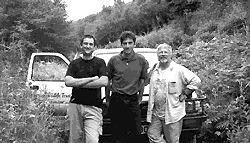BADGERS
Your opinion counts
This "protected" species continues
to suffer considerable losses within our county from development, road
accidents and, of course, the Krebs "experiment" with our wildlife in
the wider countryside. Following the initial culls in east and west Cornwall,
we are told that MAFF removed 697 badgers from the county's population
and of course they will return to remove more.
At last other aspects of the bovine
TB problem are being looked at, but the vastly overweighted funding put
to the cull remains; only the smallest portion is set aside to divide
among the many other issues that may finally assist farmers with this
seemingly endless problem.
How many of us know where our nearest
badger sett may be, or perhaps take the trouble to keep an eye on it?
That in itself would be a valuable contribution whereby we could learn
more of the habits of our wildlife, as indeed we do upon watching any
of the wildlife that enhances and surrounds our daily lives.
Such observation may be particularly
helpful in west Cornwall, for the cull will have created an element of
dispersal together with the natural movement that takes place for some
badgers during the autumn months. People in the west of the county were
particularly upset by the removal of this symbol of British wildlife,
and in response to their opposition their
representatives were able to put forward
motions of opposition to both the County and Penwith District Councils.
Both Councils supported the motions of opposition by worthwhile majorities,
representing the public outrage. Public opinion counts!
It is important for people to know
more about the problems that beset the badger, and about the present reasoning.
To this end it is likely that a badger group will be set up in the west
of the county. Contact can be made through BROCK on (01726) 813469 or
directly to Roger Driver on (01736) 363167.
John Starnes
BROCK
WRITE ON
Do you have a question about wildlife
for which you would like an expert answer? Do you have strong views on
an issue which you would like to air? Do you have any wildlife observations
or experiences which you would like to share with us? If so, do please
write to Wild Cornwall - we would love to hear from you and to print some
of your letters.
Mark Nicholson
